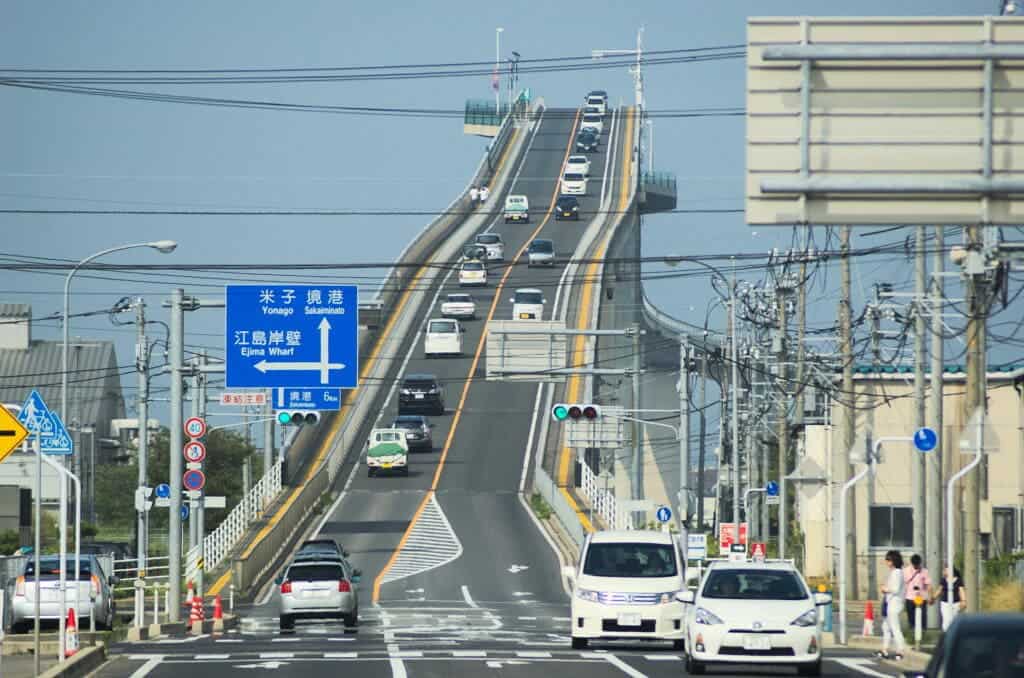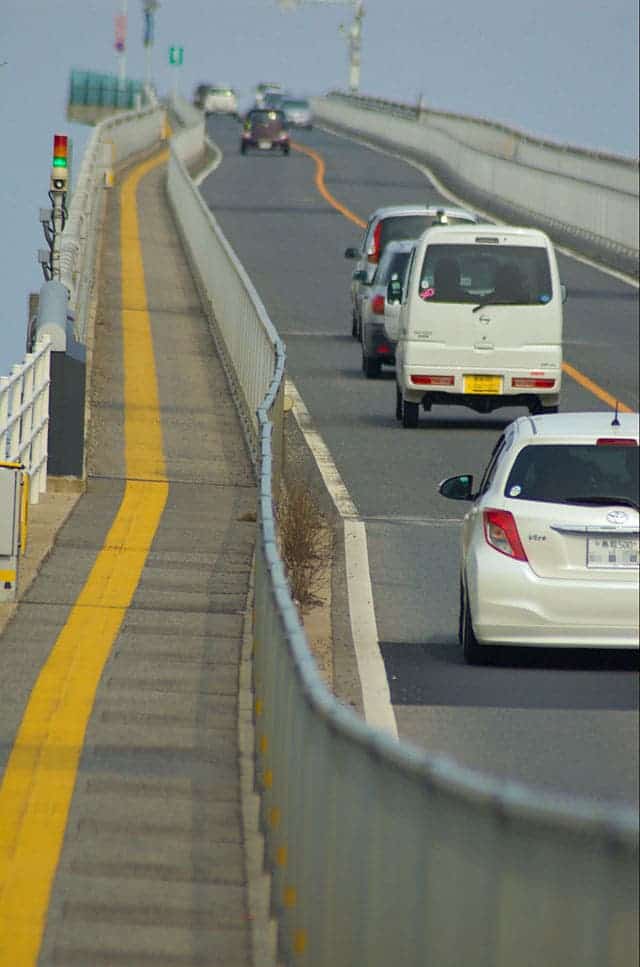In southwestern Japan, the prefectures of Tottori and Shimane were separated by a lake. The lake, called Nakaumi, made it hard for people to get from one side to the other, so in 1997, Japanese engineers and architects started working on a bridge. But there was a catch: ships also sailed the lake, so the bridge had to be tall enough to allow ships to pass beneath. That’s how the terrifyingly steep Eshima Ohashi bridge came to be.

The bridge has a slope gradient of 5.1% on one side and 6.1% on the other. It’s a mile long (1.6 km) and 144 feet tall (44 meters). It’s one of the tallest rigid frame bridges in the world, connecting the two busy cities on opposite sides of the lake.
Before the bridge was built, every time a ship would pass, traffic would have to be restricted for up to 8 minutes, and only vehicles under 14 tons were allowed to cross the bridge. There was also a limit of 4,000 vehicles that could cross per day. So traffic between the two Japanese prefectures was often delayed, and traversing the lake was a drag. The Eshima Ohashi bridge solved most of those problems, by being tall enough that ships can go under it — the only downside is that the bridge had to be high and steep.
In truth, it’s steep but not that steep. Many of the photos you see of it were taken from a distance using a telephoto lens, which distorts the perspective and makes it look like the bridge is steeper than it is. Images of the bridge have widely circulated, and a popular commercial was also shot in the area, carefully designed to make the bridge look as steep as possible by forcing the perspective of the images. The place became a sort of a legend, but as it’s often the case, reality doesn’t look exactly like the photos.
In some images, the bridge looks a bit like the upward slope of a roller coaster, creating the illusion that cars are going up a cliff. However, that’s also a bit of an optical illusion, or rather a distortion in the visual field of perception. The telephoto lenses often used to take these photos “flatten” the visual field, making it seem like the lowest point of the bridge is much closer to the highest point of the bridge than it really is, creating an illusion of extra steepness.

Here is how different the bridge looks from the perspective of an observer (first video) and from the perspective of a driver crossing the bridge (second video).
Still, the bridge is nothing to scoff at, and in Japan, it’s often referred to as a betabumi-zaka — ‘a pedal-to-the-metal slope’. Depending on your car, you may not need to push the gas all the way down, but it’s still a slope to be considered carefully. It’s not the only betabumi-zaka in Japan, several other such structures exist in Tokyo and Osaka.
Special provisions are in place, especially in the winter, to make sure that the surface doesn’t become ice- or snow-covered. However, while you may want to be sure your brakes are working before going on the bridge, it’s not exactly a rollercoaster

The bridge has become something of a tourist attraction in its own right. It’s fairly easy to reach: you can either drive on it or use a taxi to get you to it and then walk on it (there is a sidewalk on both sides). If you want to recreate the famous photos, there is a convenience store at the intersection on the Shimane side. If you do walk or cycle on the bridge, make sure to also climb to the top and enjoy the lovely view of the lake and Daikon island (telescopes and binoculars are freely available for tourists).
The nearby Daikon island itself is an interesting site. It’s a Japanese garden and the country’s largest producer of peony seedlings. Around 20,000 peonies of 250 different species are raised here and historically, growing and peddling seedlings was a job for the women on the island.
All in all, the Eshima Ohashi bridge may not be as incredibly steep as some photos make it out to be, but it’s still a sight to behold, and an important engineering accomplishment. It has connected two cities and bridged the gap between the relatively isolated Sanin region and the rest of Japan, helping the area develop economically in the past few decades. Like we’ve come to expect from Japan, it’s good, solid, and useful engineering.


